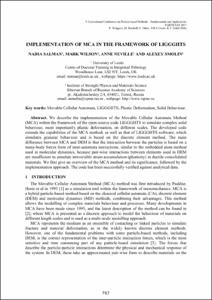Implementation of mca in the framework of liggghts

Estadístiques de LA Referencia / Recolecta
Inclou dades d'ús des de 2022
Cita com:
hdl:2117/187568
Tipus de documentText en actes de congrés
Data publicació2017
EditorCIMNE
Condicions d'accésAccés obert
Tots els drets reservats. Aquesta obra està protegida pels drets de propietat intel·lectual i
industrial corresponents. Sense perjudici de les exempcions legals existents, queda prohibida la seva
reproducció, distribució, comunicació pública o transformació sense l'autorització del titular dels drets
Abstract
We describe the implementation of the Movable Cellular Automata Method (MCA) within the framework of the open-source code LIGGGHTS to simulate complex solid behaviour; most importantly plastic deformation, on different scales. The developed code extends the capabilities of the MCA method, as well as that of LIGGGHTS software; which simulates granular behaviour and is based on the discrete element method. The main difference between MCA and DEM is that the interaction between the particles is based on a many-body forces form of inter-automata interactions, similar to the embedded atom method used in molecular dynamics, because pair-wise interactions between elements used in DEM are insufficient to simulate irreversible strain accumulation (plasticity) in ductile consolidated materials. We first give an overview of the MCA method and its significance, followed by the implementation approach. The code has been successfully verified against analytical data.
ISBN978-84-946909-7-6
| Fitxers | Descripció | Mida | Format | Visualitza |
|---|---|---|---|---|
| Particles_2017- ... f MCA in the framework.pdf | 560,4Kb | Visualitza/Obre |

